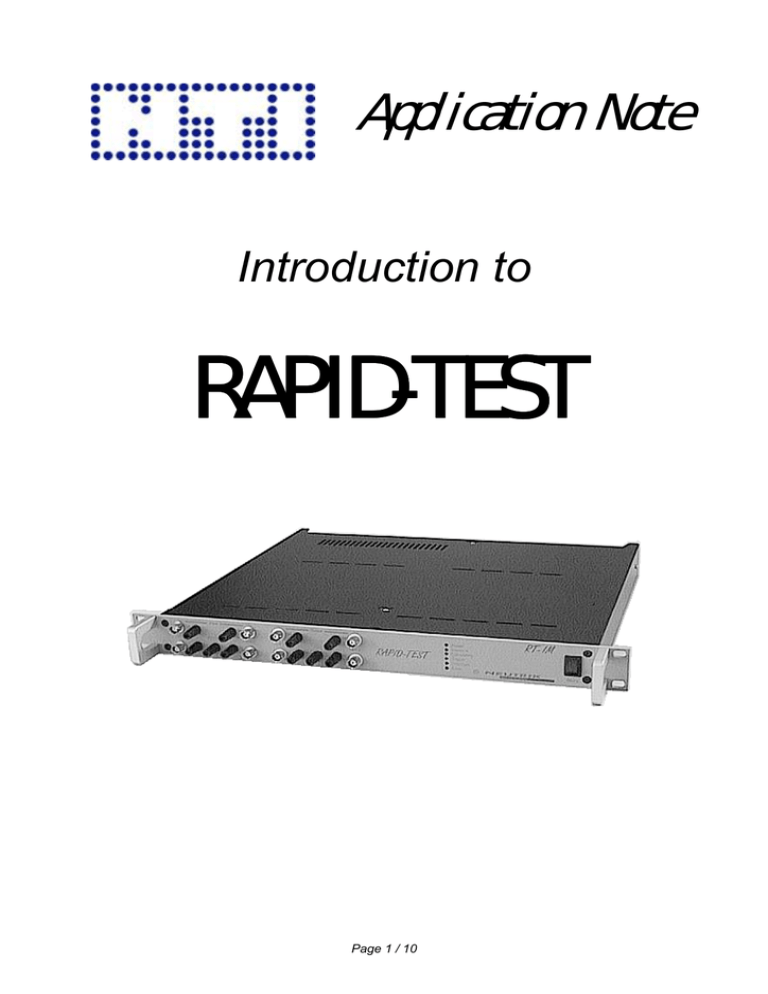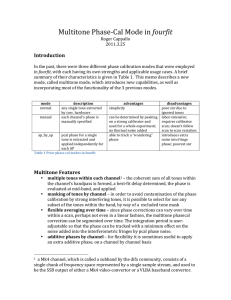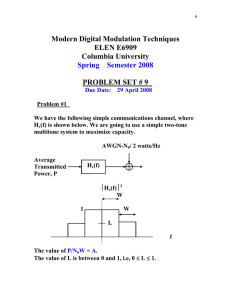introduction to rt-1m
advertisement

Application Note Introduction to RAPIDRAPID-TEST Page 1 / 10 RT-2M / RT-2X Introduction to Rapid Test ABSTRACT With the RAPID-TEST instruments, NTI offers a series of powerful multitone analyzers for an extremely fast, yet precise audio performance analysis. Each type of the series allows the 2-channel analysis of frequency response, distortion, noise, phase and crosstalk within a minimum of time. GENERAL INFORMATION Multitone Signal Analysis Conventional audio test sets normally transmit single sine waves for signal analysis. On the other hand, RAPID-TEST generates and analyses multitone signals, i.e. a mixture of several sine waves with different frequencies. Displayed on an oscilloscope, a multitone signal almost resembles noise, while on a spectrum analyzer the single frequencies become visible. Fig 1 Time Plot of 3-Freq. Multitone Signal Fig 2 Spectrum of 3-Freq. Multitone Signal One major advantage of multitone signals is that they correspond much closer with real world signals like human speech or music than any single sinusoidal wave (especially when testing data reducing devices). Furthermore, since several audio parameters may be measured in one step lasting only fractions of a second, all applications where time is a bottleneck profit from the enormous analysis speed with multitone signals. In practice, multitone signal analysis ideally fits for virtually any application where audio transmission characteristics of a component, line or system shall be evaluated. Please notice, that RAPID-TEST is available either with analog-only or analog & digital (ISDN) in-/outputs. Page 2 / 10 RT-2M / RT-2X Introduction to Rapid Test Typical Applications of RAPID-TEST RAPID-TEST allows measurements of Level, Distortion, Noise, Crosstalk and Phase of received multitone bursts. These features may be used e.g. in following applications. • Quality Control of (cellular) phones covering Receive, Transmit, Ringer and Speaker testing • Analysis of stationary DTMF (Double Tone Multiple Frequency) signals • Loudspeaker evaluation in a production line • High-speed line testing in telecom environments • Automated measurements of broadcast networks • Satellite communication testing. Consequently, typical customers of RAPID-TEST are (cellular) phone manufacturers, high volume audio device manufacturers (e.g. CD players, tape recorders, mixers, microphones, loudspeakers, modems, PC sound cards etc.) broadcast and telecom companies, studios, satellite network operators etc. Mode of Operation For any multitone burst transmission and measurement of the results, a multitone generator & analyzer is required, as they are provided in every RAPID-TEST unit. However, it is also possible that two units are located remotely or to use an external generator (e.g. a cellular phone) and to analyze its signal with RAPID-TEST. Next, the multitone signal has to be defined, comprising the frequencies (up to 31) to be transmitted. These frequencies, together with additional signal components, form the multitone burst, which is transmitted through the device under test (DUT). In detail, a RAPID-TEST generated multitone signal has a typical duration of typ. 250-960ms and consists of 1. a coded signal, called trigger, which tells any listening analyzer that a multitone burst is on the way. 2. a synchronization block which allows the analyzer to adjust itself onto the generator clock. 3. the multitone signal to be analyzed, which may be repeated within the burst up to 5 times, if required. In case of externally generated signals, neither trigger nor synchronization block are necessary. However, in this mode level analysis is possible only (no distortion, noise, crosstalk, phase). As soon as the multitone burst is received by a listening RAPID-TEST, it is analyzed in order to evaluate the characteristics of the transmission path. Page 3 / 10 RT-2M / RT-2X Introduction to Rapid Test Following picture provides a good overview on the RAPID-TEST mode of operation. Fig 3 RAPID-TEST Mode of Operation Control Software Depending on the use of RAPID-TEST, different software solutions are available from NTI free of charge. • RT-EVAL was designed for evaluation purposes, i.e. for an easy-to-understand lead-in into running RAPID-TEST, but also provides a code generator to support the integration of the unit into an automated environment. ® ® • The LabView or LabWindows driver libraries, running with GPIB interface boards from National Instruments™, ease the programming under the respective language. If you are in doubt about how to integrate RAPID-TEST into your application, ask your next NTI representative, he will assist you in finding an optimal solution for your demands. Communication Interface Due to performance reasons, the communication between RAPID-TEST and the host controller is done through an IEEE-488 parallel interface. • This IEEE interface (GPIB) allows to take full advantage of the speed of a multitone signal analysis • Furthermore, IEEE interfaces allow to control up to 31 instruments simultaneously from a single PC. Additionally, an RS232 serial interface allows to download new firmware versions to the instrument, or even to control the unit. Page 4 / 10 RT-2M / RT-2X Introduction to Rapid Test APPLICATION EXAMPLES 1 Quality Control of (Cellular) Phones Goal Evaluation of the audio transmission characteristics of analog or ISDN phones, including phone-specific signal analysis (ringer, DTMF keys etc.). Set-Up • Connect the RAPID-TEST output to the input of the cellular phone. • Connect a RF-demodulator to input of RAPID-TEST. Fig 4 Standard Phone Test Procedure • Define a multitone signal in the telecom frequency range (typically 300Hz, 1kHz, 3kHz). • Transmit the burst through the phone and RF-demodulator back to RAPID-TEST. • Compare the processed data with the specified tolerances. Hint Apply the same setup for Receive tests of phones, however with the input of RAPID-TEST connected to the phone earpiece and the output of RAPID-TEST connected to the RF-modulator input. Page 5 / 10 RT-2M / RT-2X Introduction to Rapid Test 2 Analysis of Externally Generated (Multitone) Signals Goal Electroacoustic analysis of signals, generated by an external system as e.g. a cellular phone (alert ringer, DTMF tones), regardless whether these signals are of single or multitone type. In this mode, the analyzer module of RAPID-TEST is used only. Set-Up • Connect input channel(s) of RAPID-TEST to the external signal source. • Optionally, a device under test (DUT) may be inserted into the signal path between the external generator and RAPID-TEST analyzer. Fig 5 External Signal Analysis Procedure • Define a (multitone) signal on the external generator. • Adjust the basic RAPID-TEST analyzer settings (blocklength, trigger etc.) according to the expected signal. • Start measurement and analyze the signal, received by RAPIDTEST. Hint It is also possible to use any consumer product (e.g. phones) as signal source instead of the indicated test instrument. Page 6 / 10 RT-2M / RT-2X Introduction to Rapid Test 3 Evaluation of Loudspeakers / Microphones Goal Measurement of the electroacoustic parameters (frequency response, distortions, noise, phase shift, crosstalk) of a microphone or speaker. Set-Up • Install an (active) loudspeaker and a precision microphone with known characteristics at defined positions in an anechoic chamber. • Connect the output of RAPID-TEST to the loudspeaker and the input to the microphone Fig 6 Microphone Test Fig 7 Loudspeaker Test Procedure • Define a multitone signal in the frequency range of interest. • Measure all audio parameters of interest and store the results as reference. • Install the transducer to be measured instead of the reference (position must be identical!) and repeat the measurement. • Calculate the difference between the result of the second test to your reference data in order to establish the characteristics of your DUT. Page 7 / 10 RT-2M / RT-2X Introduction to Rapid Test 4 Arbitrary Signal Generator Goal Definition and generation of arbitrary signals, which may either be transmitted for a certain number of times or endlessly. In this mode, the generator module of RAPID-TEST is used only. Set-Up • Connect output channel(s) of RAPID-TEST to the device under test (DUT). Fig 8 RAPID-TEST as Arbitrary Signal Generator Procedure • Define a (multitone) signal on the RAPID-TEST generator. • Send the signal each desired time or repetitively. Page 8 / 10 RT-2M / RT-2X Introduction to Rapid Test 5 Transmission Line Testing Goal To measure long distance transmission lines, the output of the sending RAPID-TEST must be connected to the base station of the transmission line. The receiving RAPID-TEST (also several analyzers are allowed) and their host PCs may be located anywhere you like. Set-Up • Define a multitone signal and feed it through the transmission line. • Arm the listening RAPID-TEST units and gather the measured data from their host PCs (e.g. through a Modem link). I H C Music Program n i g p h H u t o O H i g 1 L h C L w o H H C 2 w i g u h H L t p u H 1 o o R t i g h C L w R H 2 A P w P o w e r I n t e r f a c C a l c u l a T r i g g e r O v e r l o a E r r o r I D E T e t i n - T T S T I I E g d N T I B S 0 S M R U T aM iE n N sT S Analyzer 1 IEEE 488 H C I n h i g H L p u t H 1 o w i g h C L o H w H C2 O h i g H L u t p H 1 o w u t i g C L o h H w R 2 A P R E P o w e r I n t e r f a c e C a l c u l a t i n T r i g g e r O v e r l o a d E r r o r I D - T T E S T T S g I N S T R T I B I 0 M U M aE i nT N s S Generator I IEEE 488 H C i g H L n h p u H 1 o w t O i g C L o h H w H C 2 i g H L u h t p H 1 o w u t i g C L o H w h R 2 A P P o w e r I n t e r f a c C a l c u l a T r i g g e r O v e r l o a E r r o r I D e t - T T E S R T i n g d T I N I E S 0 T M R I B S U T aM iE n N sT S Analyzer 2 IEEE 488 Fig 9 Transmission Line Test Please notice that for radio transmission tests, the broadcast program must be interrupted shortly to introduce the multitone burst. Page 9 / 10 RT-2M / RT-2X Introduction to Rapid Test RAPID-TEST PRODUCT OVERVIEW GPIB Board from National Instruments™+ RT-EVAL or LabWindows CVI or LabView driver library or application-specific Program (C, BASIC etc.) IEEE 488 I n p u t H C H I O H I 1 L O C H H L O 2 C H I u tp u t H I 1 L O C H 2 P o w e r I n te r fa c e C a l c u la t in g T r ig g e r O v e r lo a d E r r o r R T - IM I R A P ID -T E S T L O T E S T 0 IN S T R U M E N T S M a in s RAPID-TEST Application Notes RT-1M A pplication RT-1M A pplication Get Familiar with Writing Code Cellular Phone Testing RT-1M A pplication RT-1M A pplication Comparing Conventional vs. Multitone Testing Speakers & Microphones* (ask your local NEUTRIK representative for a copy) RT-1M A pplication Introduction *: to be released Page 10 / 10



